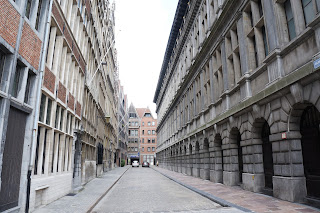This is the medieval "Hoogbrug" (High Bridge) or "Grootbrug" (Great Bridge) and the medieval tollhouse.
The "Great Bridge" dates from the 13th century and is still in service. In the 19th century the parapets were removed and replaced by a wrought iron railing. People thought at the time that the bridge was ready to collapse under the weight. Probably the assesment was wrong and the change was not necessary. The bridge is still standing and we can still enjoy the sight of it. Imagine how strong it was built to last for over 700 years already. Now wonder its name at the time.


The tollhouse was built right over the water to have a good view on the ships coming into the city. From the modern floating walkway you have a nice sight on the underside of the building. You can even see part of the stairs to the basement sticking out. The tollhouse is now a small special wine store.
The "Great Bridge" dates from the 13th century and is still in service. In the 19th century the parapets were removed and replaced by a wrought iron railing. People thought at the time that the bridge was ready to collapse under the weight. Probably the assesment was wrong and the change was not necessary. The bridge is still standing and we can still enjoy the sight of it. Imagine how strong it was built to last for over 700 years already. Now wonder its name at the time.
The tollhouse was built right over the water to have a good view on the ships coming into the city. From the modern floating walkway you have a nice sight on the underside of the building. You can even see part of the stairs to the basement sticking out. The tollhouse is now a small special wine store.











